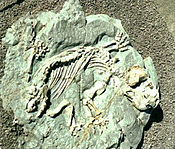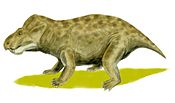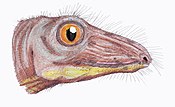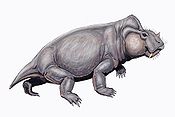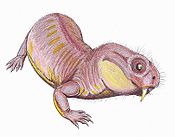This list of therapsids is an attempt to create a comprehensive listing of all genera that have ever been included in the Therapsida excluding mammals and purely vernacular terms. The list includes all commonly accepted genera, but also genera that are now considered invalid, doubtful (nomina dubia), or were not formally published (nomina nuda), as well as junior synonyms of more established names, and genera that are no longer considered therapsids.
The list currently contains 510 generic names.
Naming conventions and terminology
Naming conventions and terminology follow the International Code of Zoological Nomenclature. Technical terms used include:
- Junior synonym: A name which describes the same taxon as a previously published name. If two or more genera are formally designated and the type specimens are later assigned to the same genus, the first to be published (in chronological order) is the senior synonym, and all other instances are junior synonyms. Senior synonyms are generally used, except by special decision of the ICZN, but junior synonyms cannot be used again, even if deprecated. Junior synonymy is often subjective, unless the genera described were both based on the same type specimen.
- Nomen nudum (Latin for "naked name"): A name that has appeared in print but has not yet been formally published by the standards of the ICZN. Nomina nuda (the plural form) are invalid, and are therefore not italicized as a proper generic name would be. If the name is later formally published, that name is no longer a nomen nudum and will be italicized on this list. Often, the formally published name will differ from any nomina nuda that describe the same specimen.
- Nomen oblitum (Latin for "forgotten name"): A name that has not been used in the scientific community for more than fifty years after its original proposal.
- Preoccupied name: A name that is formally published, but which has already been used for another taxon. This second use is invalid (as are all subsequent uses) and the name must be replaced. As preoccupied names are not valid generic names, they will also go unitalicized on this list.
- Nomen dubium (Latin for "dubious name"): A name describing a fossil with no unique diagnostic features. As this can be an extremely subjective and controversial designation, this term is not used on this list.
The list
|
See also
References
- ^ Battail, B. & Surkov, M. V. Mammal-like reptiles from Russia. In Benton, M. J.; Shishkin, M. A.; Unwin, D. M.; Kurochkin, E. N. "The Age of Dinosaurs in Russia and Mongolia". Cambridge University Press, 2001. 672 p.
- ^ Carroll, R. L. "Vertebrate Paleontology and Evolution". W. H Freeman Company, 1988.
- ^ Lucas, Spencer G. (January 2006). "Global Permian tetrapod biostratigraphy and biochronology". Non-marine Permian biostratigraphy and biochronology. Geological Society, London, Special Publications. 265 (1): 65–93. Bibcode:2006GSLSP.265...65L. doi:10.1144/GSL.SP.2006.265.01.04. S2CID 129613959.
- ^ Ivakhnenko, M. F. (2008). "The first whaitsiid (Therocephalia, Theromorpha) from the terminal Permian of Eastern Europe". Paleontological Journal. 42 (4): 409–413. doi:10.1134/s0031030108040102. S2CID 140547244.
- ^ Lucas, S. G. "Chinese Fossil Vertebrates". Columbia University Press, New York, 2001.
- ^ Modesto, S. P. & Rybcynski, N. The amniote faunas of the Russian Permian: implications for Late Permian terrestrial vertebrate biogeography. In Benton, M. J.; Shishkin, M. A.; Unwin, D. M.; Kurochkin, E. N. "The Age of Dinosaurs in Russia and Mongolia". Cambridge University Press, 2001. 672 p.
- ^ Reisz, R. R.; Dilkes, D. W. (1992). "The taxonomic position of Anningia megalops, a small amniote from the Permian of South Africa". Canadian Journal of Earth Sciences. 29 (7): 1605–1608. Bibcode:1992CaJES..29.1605R. doi:10.1139/e92-126.
- ^ Angielczyk, K. D. (2004). "Phylogenetic evidence for and implications of a dual origin of propaliny in anomodont therapsids (Synapsida)". Paleobiology. 30 (2): 268–296. doi:10.1666/0094-8373(2004)030<0268:pefaio>2.0.co;2. S2CID 86147610.
- ^ Rubidge, B. S. (1994). "Australosyodon, the first primitive anteosaurid dinocephalian from the Upper Permian of Gondwana". Palaeontology. 37 (3): 579–594.
- ^ Reisz, R. R.; Heaton, M. J. (1982). "Bayloria morei Olson 1941 identified as an immature specimen of the Permian reptile Captorhinus aguti (Cope, 1882)". Canadian Journal of Earth Sciences. 19 (6): 1232–1234. Bibcode:1982CaJES..19.1232R. doi:10.1139/e82-104.
- ^ Gao, K.; Fox, R.C.; Zhou, C.-F.; Li, D.-Q. (2010). "A new nonmammalian eucynodont (Synapsida, Therapsida) from the Triassic of northern Gansu Province, China, and its biostratigraphic and biogeographic implications". American Museum Novitates (3685): 1–25. doi:10.1206/649.1. hdl:2246/6069. S2CID 85789838.
- ^ Kemp, T. S. "The Origin & Evolution of Mammals". Oxford University Press, 2005.
- ^ Tverdokhlebov, V. P.; Tverdokhlebova, G. I.; Surkov, M. v.; Minikh, A. V.; Benton, M. J. (2005). "Upper Permian vertebrates and their sedimentological context in the South Urals, Russia" (PDF). Earth-Science Reviews. 69 (1–2): 27–77. Bibcode:2005ESRv...69...27T. doi:10.1016/j.earscirev.2004.07.003.
- ^ Watabe, M.; Tsubamoto, T. & Tsogtbaatar, K. 2007. "A new tritylodontid synapsid from Mongolia". Acta Palaeontologica Polonica 52 (2): 263–274.
- ^ Li, J (2000). "The most primitive lower tetrapod fauna in China". Science in China Series D: Earth Sciences. 44 (1): 47–51. doi:10.1007/bf02906884. S2CID 129894524.
- ^ Sues, H.-D.; Olsen, P. E. (1990). "Triassic vertebrates of Gondwanan aspect from the Richmond basin of Virginia". Science. 249 (4972): 1020–1022. Bibcode:1990Sci...249.1020S. CiteSeerX 10.1.1.637.7391. doi:10.1126/science.249.4972.1020. PMID 17789610. S2CID 36310187.
- ^ Bruner, J. C. (1991). "A catalogue of Type Specimens of Fossil Vertebrates in the Field Museum of Natural History. Classes Amphibia, Reptilia, Aves and ichnites". Geology. 22: 1–68. doi:10.5962/bhl.title.3392.
- ^ Bonaparte, J. F.; Martinelli, A. G.; Schultz, C. L. (2005). "New information on Brasilodon and Brasilitherium (Cynodontia, Probainognathia) from the Late Triassic of southern Brazil". Revista Brasileira de Paleontologia. 8 (1): 25–46. doi:10.4072/rbp.2005.1.03.
- ^ Rubidge, B. S.; Sidor, C. A. (2002). "On the cranial morphology of the basal therapsids Burnetia and Proburnetia (Therapsida: Burnetiidae)". Journal of Vertebrate Paleontology. 22 (2): 257–267. doi:10.1671/0272-4634(2002)022[0257:otcmot]2.0.co;2. S2CID 86207308.
- ^ Abdala, F. & Ribeiro, A. M. 2000. "A new therioherpetid cynodont from the Santa Maria Formation (middle Late Triassic), southern Brazil". Geodiversitas 22 (4 : 589-596.
- ^ Tverdokhlebov, V. P.; Tverdokhlebova, G. I.; Surkov, M. V.; Benton, M. J. (2002). "Tetrapod localities from the Triassic of the SE of European Russia". Earth-Science Reviews. 60 (1–2): 1–66. doi:10.1016/s0012-8252(02)00076-4.
- ^ Abdala, F (1996). "Redescripción del cráneo y reconsideración de la validez de Cynognathus minor (Eucynodontia, Cynognathidae) del Triásico Inferior del Mendoza". Ameghiniana. 33 (2): 115–126.
- ^ Kammerer, C. F.; Flynn, J. J.; Ranivoharimanana, L.; Wyss, A. R. (2008). "New material of Menadon besairiei (Cynodontia, Traversodontidae) from the Triassic of Madagascar". Journal of Vertebrate Paleontology. 28 (2): 445–462. doi:10.1671/0272-4634(2008)28[445:nmombc]2.0.co;2. S2CID 140720709.
- ^ Prasad, G. V. R. "Sedimentary Basins and Fossil Records". In Singhvi, A. K.; Bhattacharya, A. & Guha, S. (eds.). Glimpses of Geo-Science Research in India: Indian Report to IUGS 2002-2008. Indian National Science Academy, 2008.
- ^ Angielczyk, K.D.; Sidor, C.A.; Nesbitt, S.J.; Smith, R.M.H.; Tsuji, L.A. (2009). "Taxonomic Revision and New Observations on the Postcranial Skeleton, Biogeography, and Biostratigraphy of the Dicynodont Genus Dicynodontoides, the Senior Subjective Synonym of Kingoria (Therapsida, Anomodontia)". Journal of Vertebrate Paleontology. 29 (4): 1174–1187. Bibcode:2009JVPal..29.1174A. doi:10.1671/039.029.0427. S2CID 85787287.
- ^ Schultz, C. L. & Langer, M. C. "Tetrápodes Triássicos do Rio Grande do Sul". Interciência, 2007.
- ^ Sidor, C. A.; Hancox, P. J. (2006). "Elliotherium kersteni, a new tritheledontid from the Lower Elliot Formation (Upper Triassic) of South Africa". Journal of Paleontology. 80 (2): 333–342. CiteSeerX 10.1.1.557.9156. doi:10.1666/0022-3360(2006)080[0333:ekantf]2.0.co;2. S2CID 130003909.
- ^ Cox, C. B. (1964). "On the palate, dentition, and classification of the fossil reptile Endothiodon and related genera". American Museum Novitates (2171): 1–20.
- ^ Rubidge, B. S.; King, G. M.; Hancox, P. J. (1994). "The postcranial skeleton of the earliest dicynodont synapsid Eodicyninodon from the Upper Permian of South Africa". Palaeontology. 37 (2): 397–408.
- ^ Dixon, D.; Cox, B.; Savage, R. J. G. & Gardine, B. (eds.). "The Macmillan Illustrated Encyclopedia of Dinosaurs and Prehistoric Animals". Macmillan Publishing Company, 1988.
- ^ Abdala, F.; Malabarba, M. C. (2007). "Enamel microstructure in Exaeretodon, a Late Triassic South American traversodontid (Therapsida: Cynodontia)". Revista Brasileira de Paleontologia. 10 (2): 71–78. doi:10.4072/rbp.2007.2.01.
- ^ Godefroit, P. 1999. "New traversodontid teeth from the Upper Triassic of Habay-la-Vieille (southern Belgium)". Paläontologische Zietschdrift 73 (3/4): 385-394.
- ^ Colbert, E. H.; Kitching, J. W. (1977). "Triassic cynodont reptiles from Antarctica". American Museum Novitates (2611): 1–30.
- ^ Botha, J.; Smith, R. H. M. (2007). "Lystrosaurus species composition across the Permo–Triassic boundary in the Karoo Basin of South Africa". Lethaia. 40 (2): 125–137. doi:10.1111/j.1502-3931.2007.00011.x.
- ^ Kurkin, A. A. (2006). "A new dicynodont from the Upper Permian of Tatarstan". Paleontological Journal. 50 (4): 434–437. doi:10.1134/S0031030106040095. S2CID 129016459.
- Liu, J (2007). "The taxonomy of the traversodontid cynodonts Exaeretodon and Ischignathus". Revista Brasileira de Paleontologia. 10 (2): 133–136. doi:10.4072/rbp.2007.2.07.
- ^ Modesto, S. P.; Rubidge, B. S.; Welman, J. (2003). "Erratum: A replacement name for Lanthanocephalus Modesto, Rubidge and Welman 2002, not Lanthanocephalus Williams and Starmer 2000". Canadian Journal of Earth Sciences. 39 (12): 1755–1765. doi:10.1139/e02-091.
- ^ Sidor, C. A.; Welman, J. (2003). "A second specimen of Lemurosaurus pricei (Therapsida: Burnetiamorpha)". Journal of Vertebrate Paleontology. 23 (3): 631–642. doi:10.1671/0272-4634(2003)023[0631:assolp]2.0.co;2. S2CID 56317227.
- ^ Sidor, C. A.; Hopson, J. A.; Keyser, A. W. (2004). "A new burnetiamorph therapsid from the teekloof formation, Permian, of South Africa". Journal of Vertebrate Paleontology. 24 (4): 938–950. doi:10.1671/0272-4634(2004)024[0938:anbtft]2.0.co;2. S2CID 85752458.
- ^ Sidor, C. A.; Smith, R. M. H. (2007). "A second burnetiamorph therapsid from the Permian of Teekloof Formation of South Africa and its associated fauna". Journal of Vertebrate Paleontology. 27 (2): 420–430. doi:10.1671/0272-4634(2007)27[420:asbtft]2.0.co;2. S2CID 86173425.
- ^ Sidor, C. A. (2003). "The naris and palate of Lycaenodon longiceps (Therapsida: Biarmosuchia), with comments on their early evolution in the Therapsida". Journal of Paleontology. 77 (5): 977–984. doi:10.1666/0022-3360(2003)077<0977:tnapol>2.0.co;2. S2CID 54000298.
- ^ Liu, J.; Soares, M. B.; Reichel, M. (2008). "Massetognathus (Cynodontia, Traversodontidae) from the Santa Maria Formation of Brazil". Revista Brasileira de Paleontologia. 11 (1): 27–36. doi:10.4072/rbp.2008.1.03.
- ^ Hammer, W. C. Fossils, Vertebrates. In Riffenburgh, B. (ed.). "Encyclopedia of the Antarctic". CRC Press, 2007.
- ^ Hopson, J. A.; Sues, H.-D. (2006). "A traversodont cynodont from the Middle Triassic of Baden-Württemberg (Germany)". Paläontologische Zeitschrift. 80 (4): 124–129. doi:10.1007/BF02988972. S2CID 128486943.
- ^ Romer, A. S. (1937). "New genera and species of pelycosaurian reptiles". Proceedings of the New England Zoological Club. XVI: 90–96.
- ^ Mazin, J. M.; King, G. M. (1991). "The first dicynodont from the Late Permian of Malagasy". Palaeontology. 34 (4): 837–842.
- ^ Rubidge, B. S.; Sidor, C. A.; Modesto, S. P. (2006). "A new burnetiamorph (Therapsida: Burnetiamorpha) from the Middle Permian of South Africa". Journal of Paleontology. 80 (4): 740–749. doi:10.1666/0022-3360(2006)80[740:anbtbf]2.0.co;2. S2CID 130196490.
- ^ Smith, R. M.; Rubidge, B. S.; Sidor, C. A. (2006). "A new burnetiid (Therapsida: Biarmosuchia) from the Upper Permian of South Africa and its biogeographic implications". Journal of Vertebrate Paleontology. 26 (2): 331–343. doi:10.1671/0272-4634(2006)26[331:anbtbf]2.0.co;2. S2CID 86367955.
- ^ Sues, H.- D.; Olsen, P. E.; Carter, J. G. (1999). "A Late Triassic Traversodont Cynodont from the Newark Supergroup of North Carolina". Journal of Vertebrate Paleontology. 19 (2): 351–354. Bibcode:1999JVPal..19..351S. doi:10.1080/02724634.1999.10011146.
- ^ Sidor, C. A.; Smith, R. M. (2004). "A new galesaurid (Therapsida: Cynodontia) from the Lower Triassic of South Africa". Palaeontology. 47 (3): 535–556. Bibcode:2004Palgy..47..535S. doi:10.1111/j.0031-0239.2004.00378.x. S2CID 129906726.
- ^ Bonaparte, J.F.; Soares, M.B.; Schultz, C.L. (2006). "A new non-mammalian cynodont from the Middle Triassic of southern Brazil and its implications for the ancestry of mammals". New Mexico Museum of Natural History and Science Bulletin. 45: 599–607.
- ^ Reichel, M.; Schultz, C. L.; Soares, M. B. (2009). "A new traversodontid cynodont (Therapsida, Eucynodontia) from the Middle Triassic Santa Maria Formation of Rio Grande do Sul, Brazil". Palaeontology. 52 (1): 229–250. Bibcode:2009Palgy..52..229R. doi:10.1111/j.1475-4983.2008.00824.x. S2CID 129081834.
- ^ Liu, J.; Rubidge, B; Li, J. (2009). "New basal synapsid supports Laurasian origin for therapsids". Acta Palaeontologica Polonica. 54 (3): 393–400. doi:10.4202/app.2008.0071.
- ^ Roychodhury, T (1970). "Two new dicynodonts from the Triassic Yerrapalli Formation of central India". Palaeontology. 13 (1): 132–144.
- ^ Reisz, R. R.; Berman, D. S. (1985). "Scoliomus puercensis Williston and Case, 1913, identified as a junior synonym of Sphenacodon ferox Marsh (Reptilia, Pelycosauria)". Canadian Journal of Earth Sciences. 22 (8): 1236–1239. Bibcode:1985CaJES..22.1236R. doi:10.1139/e85-126.
- ^ Langston, W (1965). "Oedalops campi (Reptilia: Pelycosauria) new genus and species from the Lower Permian of New Mexico and the family Eothryrididae". Bulletim of Texas Memorial Museum. 9: 1–45.
- Conrad, J.; Sidor, C. A. (2001). "Re−evaluation of Tetraceratops insignis (Synapsida: Sphenacodontia)". Journal of Vertebrate Paleontology. 21: 1–117. doi:10.1080/02724634.2001.10010852. S2CID 220414868.
- ^ Oliveira, T.V.; Soares, M.B.; Schultz, C.L. (2010). "Trucidocynodon riograndensis gen. nov. et sp. nov. (Eucynodontia), a new cynodont from the Brazilian Upper Triassic (Santa Maria Formation)". Zootaxa. 2382: 1–71. doi:10.11646/zootaxa.2382.1.1. S2CID 86916094.













